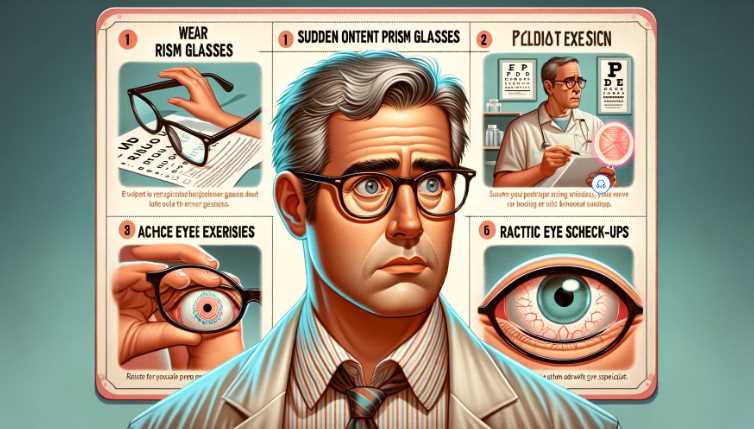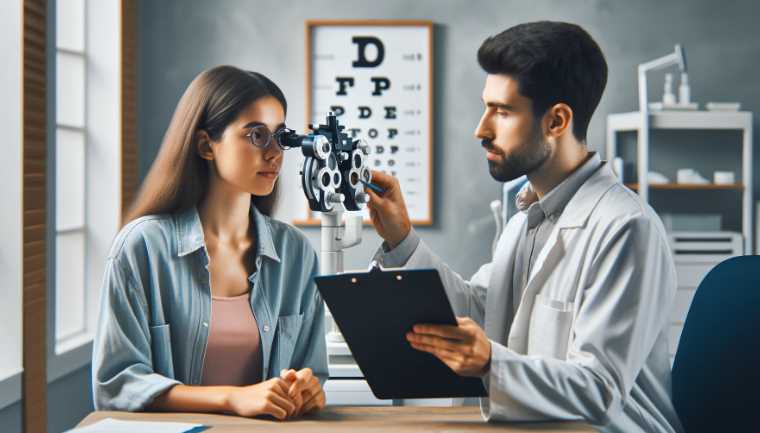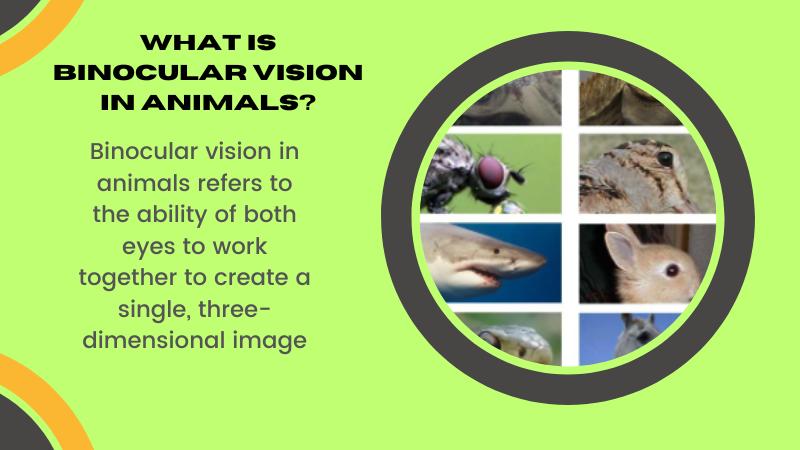To test for binocular vision dysfunction, you can perform the following simple tests:
- Cover Test:
- Ask the person to focus on a distant object.
- Cover one eye with an opaque object (e.g., an eye patch).
- Observe the uncovered eye for any movement. Repeat for the other eye.
- Near Point of Convergence (NPC):
- Have the person focus on a near object (e.g., a pen) as you slowly bring it closer to their nose.
- Note the distance at which one eye deviates or they report seeing double.
- Stereopsis Test:
- Use a stereopsis chart (e.g., Stereo Fly Test) to assess depth perception.
- Eye Movement Testing:
- Evaluate smooth pursuits and saccades by tracking a moving object.
Binocular vision dysfunction occurs when the eyes struggle to work together, leading to issues like eye strain, double vision, and headaches. The tests mentioned above assess different aspects of binocular vision.
- Cover Test:
- Detects strabismus (misalignment of eyes).
- If one eye moves to fixate when the other is covered, it suggests a misalignment.
- Near Point of Convergence (NPC):
- Assesses the ability of eyes to converge on a near object.
- Normal NPC is around 3-5 cm; an inability to converge may indicate dysfunction.
- Stereopsis Test:
- Measures depth perception.
- Poor stereopsis can be a sign of binocular vision issues.
- Eye Movement Testing:
- Assesses the smoothness and accuracy of eye movements.
- Jerky or inaccurate movements may indicate dysfunction.
Table:
| Test | Purpose | Procedure | Interpretation |
|---|---|---|---|
| Cover Test | Detects strabismus (misalignment of eyes) | – Focus on a distant object – Cover one eye and observe for movement – Repeat for the other eye | Movement of the uncovered eye indicates misalignment |
| Near Point of Convergence (NPC) | Assesses near vision and eye convergence | – Focus on a near object (e.g., pen) – Bring it closer to the nose, note the distance at which eyes deviate or see double | Inability to converge or double vision may indicate dysfunction |
| Stereopsis Test | Measures depth perception | – Use a stereopsis chart (e.g., Stereo Fly Test) | Poor stereopsis may indicate binocular vision issues |
| Eye Movement Testing | Assesses smooth pursuits and saccades | – Track a moving object with eyes | Jerky or inaccurate movements may indicate dysfunction |
Signs and Symptoms of Binocular Vision Dysfunction

Heterophoria and Heterotopia
Binocular Vision Dysfunction (BVD) often manifests through heterophoria and heterotropia, indicating misalignments of the eyes. Heterophoria refers to a latent misalignment, noticeable only during specific conditions, while heterotropia involves a manifest misalignment, visible at all times.
Detecting Heterophoria
Heterophoria can be subtle, with the eyes deviating slightly when fatigued or stressed. This may lead to intermittent double vision or eye strain, making it crucial to observe eye alignment in varied circumstances.
Recognizing Heterotropia
Heterotropia is more apparent, with one eye visibly deviating from its normal position. This misalignment may lead to a constant struggle to maintain single vision, contributing to discomfort.
Ocular Misalignment
Ocular misalignment, a hallmark of BVD, results in the eyes failing to converge properly on a single point. This can lead to diplopia (double vision) and affect depth perception, impacting activities requiring precise coordination of both eyes, such as reading or driving.
Eye Fatigue and Strain
Individuals with BVD often experience persistent eye fatigue and strain, particularly after engaging in visually demanding tasks. The extra effort required to align the eyes and maintain focus can lead to discomfort, making it challenging to sustain visual tasks for extended periods.
Double Vision
Double vision, or diplopia, is a prevalent symptom of BVD. It occurs when the brain receives conflicting images from the eyes due to misalignment. This visual disruption can significantly impact daily activities, causing discomfort and reducing overall visual efficiency.
Headaches and Migraines
Frequent headaches and migraines are common complaints among individuals with BVD. The strain on eye muscles and the brain’s effort to reconcile disparate visual information can lead to recurrent headaches, often accompanied by light sensitivity and nausea.
Difficulty with Reading and Concentration
BVD can impede reading fluency and concentration. Individuals may struggle to maintain focus on text, experiencing words or letters moving on the page. This can lead to a decline in academic or work performance.
Importance of Testing for Binocular Vision Dysfunction

Early Detection and Intervention
Detecting Binocular Vision Dysfunction (BVD) early is crucial for timely intervention. Early identification allows for the implementation of corrective measures, preventing the progression of symptoms and reducing the impact on daily life.
The Significance of Timely Intervention
Early intervention can alleviate discomfort associated with BVD symptoms, ensuring individuals can engage in visual tasks with greater ease and efficiency.
Preventing Academic and Occupational Challenges
Testing for BVD is instrumental in preventing academic and occupational challenges. Identifying and addressing BVD in students can enhance their learning experience by mitigating difficulties related to reading, concentration, and comprehension.
Enhancing Workplace Productivity
In the professional sphere, timely testing and intervention can prevent challenges related to eye strain and discomfort, thus fostering a more productive and comfortable work environment.
Relationship Between BVD and Learning Disabilities
Understanding the relationship between BVD and learning disabilities is paramount. Testing for BVD in individuals with learning challenges can unveil underlying visual issues, leading to a more comprehensive approach in addressing both visual and learning difficulties.
Holistic Approach to Learning Disabilities
A holistic approach that includes testing for BVD ensures that visual factors contributing to learning disabilities are identified and appropriately managed.
Types of Tests for Binocular Vision Dysfunction

Visual Acuity Tests
Snellen Chart and LogMAR Chart
Visual acuity tests, utilizing charts like the Snellen and LogMAR, assess the clarity of vision at different distances. These tests are foundational in determining overall visual acuity and identifying potential refractive errors.
Near Visual Acuity Tests
Near visual acuity tests focus on assessing the clarity of vision at close distances, essential for tasks like reading. These tests complement distance visual acuity assessments, providing a comprehensive evaluation of an individual’s visual capabilities.
Cover Test and Ocular Alignment
Assessing Strabismus
The cover test is instrumental in detecting strabismus, an ocular misalignment condition. By observing the eyes’ movements when one is covered, this test reveals any misalignment issues contributing to BVD symptoms.
Detecting Phorias
Ocular alignment tests, including the cover test, also help in identifying phorias—latent misalignments not always evident but contributing to BVD symptoms under specific conditions.
Stereopsis Tests
Randot Stereotest
Stereopsis tests, like the Randot Stereotest, evaluate the ability to perceive depth. This is crucial in assessing the coordination of both eyes and detecting issues that may contribute to binocular vision dysfunction.
Titmus Stereotest
Similar to the Randot Stereotest, the Titmus Stereotest is another tool for evaluating stereopsis. These tests provide valuable insights into the eyes’ ability to work together harmoniously.
Convergence and Accommodation Tests
Near Point of Convergence
Tests for near point convergence assess the eyes’ ability to converge on a near target. This is vital in identifying issues related to eye coordination during close-up tasks.
Accommodative Amplitude
Accommodative amplitude tests evaluate the eyes’ ability to adjust focus from near to far distances. Deficiencies in accommodation can contribute to symptoms of binocular vision dysfunction.
Incorporating these diverse tests provides a comprehensive evaluation, ensuring that different aspects of binocular vision dysfunction are thoroughly examined and addressed.
Professional Evaluation for Binocular Vision Dysfunction
Importance of Consulting an Optometrist or Ophthalmologist
Seeking professional evaluation from an optometrist or ophthalmologist is paramount in diagnosing and managing Binocular Vision Dysfunction (BVD). These specialists possess the expertise to conduct comprehensive assessments and employ specialized tests to identify specific issues affecting binocular vision.
Expert Guidance
Optometrists and ophthalmologists bring specialized knowledge and experience to thoroughly evaluate visual health, ensuring accurate diagnosis and tailored treatment plans.
Comprehensive Eye Exam vs. Standard Vision Screening
A comprehensive eye exam surpasses standard vision screenings, as it delves into intricate aspects of binocular vision. Vision screenings may overlook subtle signs of BVD, emphasizing the necessity of a more detailed examination.
Uncovering Subtle Issues
Comprehensive eye exams are designed to detect subtle abnormalities in eye movement, alignment, and coordination, offering a more nuanced understanding of binocular vision health.
Specialized Tests for BVD Diagnosis
Specialized tests tailored for BVD diagnosis form a crucial component of professional evaluations. These tests target specific aspects of binocular vision, providing in-depth insights into issues such as convergence, accommodation, and stereopsis.
Targeted Assessment
Specialized tests enable a targeted assessment, facilitating the identification of nuanced binocular vision challenges that may go undetected in standard eye exams.
Home Tests and Self-Assessment
Limitations and Risks
While home tests and self-assessments can offer preliminary insights, they come with limitations and risks. These assessments may not cover the breadth of BVD symptoms, and self-interpretation can lead to misdiagnosis.
Importance of Professional Evaluation
While home tests can raise awareness, a professional evaluation by an optometrist or ophthalmologist is indispensable for accurate diagnosis and appropriate intervention.
Basic Exercises to Identify Potential BVD Symptoms
Simple exercises, such as tracking an object or focusing at varying distances, can be performed at home to identify potential BVD symptoms. These exercises, however, are not a substitute for professional evaluation and are more indicative than diagnostic.
Raising Awareness
Basic exercises can help individuals recognize discomfort or difficulty in visual tasks, prompting them to seek professional guidance for a comprehensive assessment.
Treatment Options for Binocular Vision Dysfunction
Corrective Lenses and Prism Glasses
Corrective lenses, such as glasses or contact lenses, are commonly prescribed to address refractive errors contributing to Binocular Vision Dysfunction (BVD). Prism glasses may also be recommended to assist in aligning the eyes more effectively.
Improving Visual Alignment
Prism glasses work by altering the direction of light entering the eyes, aiding individuals with eye misalignments in achieving better binocular vision.
Vision Therapy
Vision therapy involves structured exercises and activities designed to enhance binocular vision skills. Customized to individual needs, vision therapy aims to improve eye coordination, focusing abilities, and overall visual processing.
Targeted Rehabilitation
Vision therapy is particularly beneficial for individuals with BVD, as it targets specific visual issues through guided exercises.
Surgical Intervention (if necessary)
In cases where non-invasive methods prove insufficient, surgical intervention may be considered. Surgical options aim to correct eye misalignments or other structural issues affecting binocular vision.
Considerations for Surgery
Surgery is typically reserved for severe cases or when other treatments have not yielded the desired outcomes.
Lifestyle Adjustments and Preventive Measures
Vision Hygiene Practices
Incorporating vision hygiene practices into daily routines can alleviate symptoms of BVD. These practices include taking regular breaks during visually demanding tasks, practicing the 20-20-20 rule, and ensuring adequate lighting.
Cultivating Healthy Vision Habits
Simple adjustments to daily habits contribute to reducing eye strain and promoting overall eye health.
Regular Eye Check-ups
Routine eye check-ups are essential in monitoring and managing Binocular Vision Dysfunction. Regular assessments by optometrists or ophthalmologists enable timely adjustments to treatment plans, ensuring ongoing visual health.
Proactive Visual Maintenance
Frequent eye check-ups contribute to proactive visual maintenance, addressing emerging issues before they escalate.
Addressing Screen Time Issues
Limiting excessive screen time and employing ergonomic practices while using digital devices are crucial in preventing exacerbation of BVD symptoms related to extended near work.
Screen Time Awareness
Conscious efforts to reduce screen time and adopt healthy digital habits contribute to maintaining visual comfort and preventing strain.
What is binocular vision dysfunction, and what symptoms indicate its presence?
Binocular vision dysfunction is a condition where the eyes struggle to coordinate effectively, leading to symptoms like eye strain, headaches, and double vision. If you experience these symptoms, it may indicate the presence of binocular vision dysfunction.
Can I perform a preliminary test at home to identify binocular vision dysfunction?
While a comprehensive evaluation by a professional is ideal, you can conduct basic tests at home. The Cover Test, Near Point of Convergence (NPC) test, and eye movement testing are simple ways to check for potential issues.
What is the Cover Test, and how does it help in detecting binocular vision dysfunction?
The Cover Test involves focusing on a distant object, covering one eye, and observing the uncovered eye for movement. If the uncovered eye moves to fixate, it suggests a misalignment, indicating the presence of binocular vision dysfunction.
How is the Near Point of Convergence (NPC) test performed, and what does it reveal?
The NPC test assesses near vision and eye convergence. By focusing on a near object (e.g., a pen) and slowly bringing it closer to the nose, the test determines the distance at which eyes deviate or report double vision. Inability to converge may indicate binocular vision dysfunction.
Is there a specific test to evaluate depth perception related to binocular vision?
Yes, the Stereopsis Test, such as the Stereo Fly Test, is used to measure depth perception. The chart assesses how well the eyes perceive depth, and poor stereopsis during this test may indicate issues with binocular vision.
What does eye movement testing involve, and how does it contribute to binocular vision assessment?
Eye movement testing evaluates smooth pursuits and saccades. By tracking a moving object with the eyes, the test assesses the smoothness and accuracy of eye movements. Jerky or inaccurate movements may indicate dysfunction in binocular vision coordination.
Are these tests suitable for children, and are there specific signs to look for in kids?
Yes, these tests are applicable to both adults and children. Children with binocular vision dysfunction may exhibit signs such as avoiding reading or complaining of headaches. Early detection is crucial for proper visual development.
How frequently should one undergo testing for binocular vision dysfunction?
Regular eye exams are essential, especially if symptoms like eye strain or headaches persist. While self-tests can be performed at home, it’s advisable to consult an eye care professional for a thorough evaluation tailored to individual needs.
What treatment options are available for binocular vision dysfunction?
Treatment options vary and may include vision therapy, prism glasses, or other interventions depending on the specific issue identified during testing. An eye care professional will recommend a personalized treatment plan.
Can binocular vision dysfunction be indicative of other underlying eye conditions?
Yes, binocular vision dysfunction may coexist with other eye conditions. Comprehensive eye exams help identify and address various visual issues, ensuring an accurate diagnosis and appropriate treatment.
Conclusion
In conclusion, treating Binocular Vision Dysfunction involves a tailored approach, considering the individual’s specific visual challenges. From corrective lenses and vision therapy to surgical options when necessary, the goal is to improve binocular vision function and alleviate associated symptoms.
Additionally, lifestyle adjustments and preventive measures are pivotal in supporting overall eye health. Regular eye check-ups and adherence to vision hygiene practices contribute to long-term well-being, emphasizing the importance of a holistic approach to managing Binocular Vision Dysfunction for an improved quality of life.
Resources and References
- Professional Organizations and Associations:
- Educational Institutions and Eye Clinics:
- University eye clinics often have informative resources on various vision conditions.
- Medical Journals and Publications:
- Articles published in journals like the Journal of Optometry or the Journal of Binocular Vision and Ocular Motility can provide in-depth information.
- Books:
- “Clinical Management of Binocular Vision” by Mitchell Scheiman and Bruce Wick

I am an enthusiastic student of optics, so I may be biased when I say that optics is one of the most critical fields. It doesn’t matter what type of optics you are talking about – optics for astronomy, medicine, engineering, or pleasure – all types are essential.
Table of Contents

Pingback: How do you fix binocular vision dysfunction?
Pingback: Binocular Vision in Animals: A Marine Biologist's Perspective